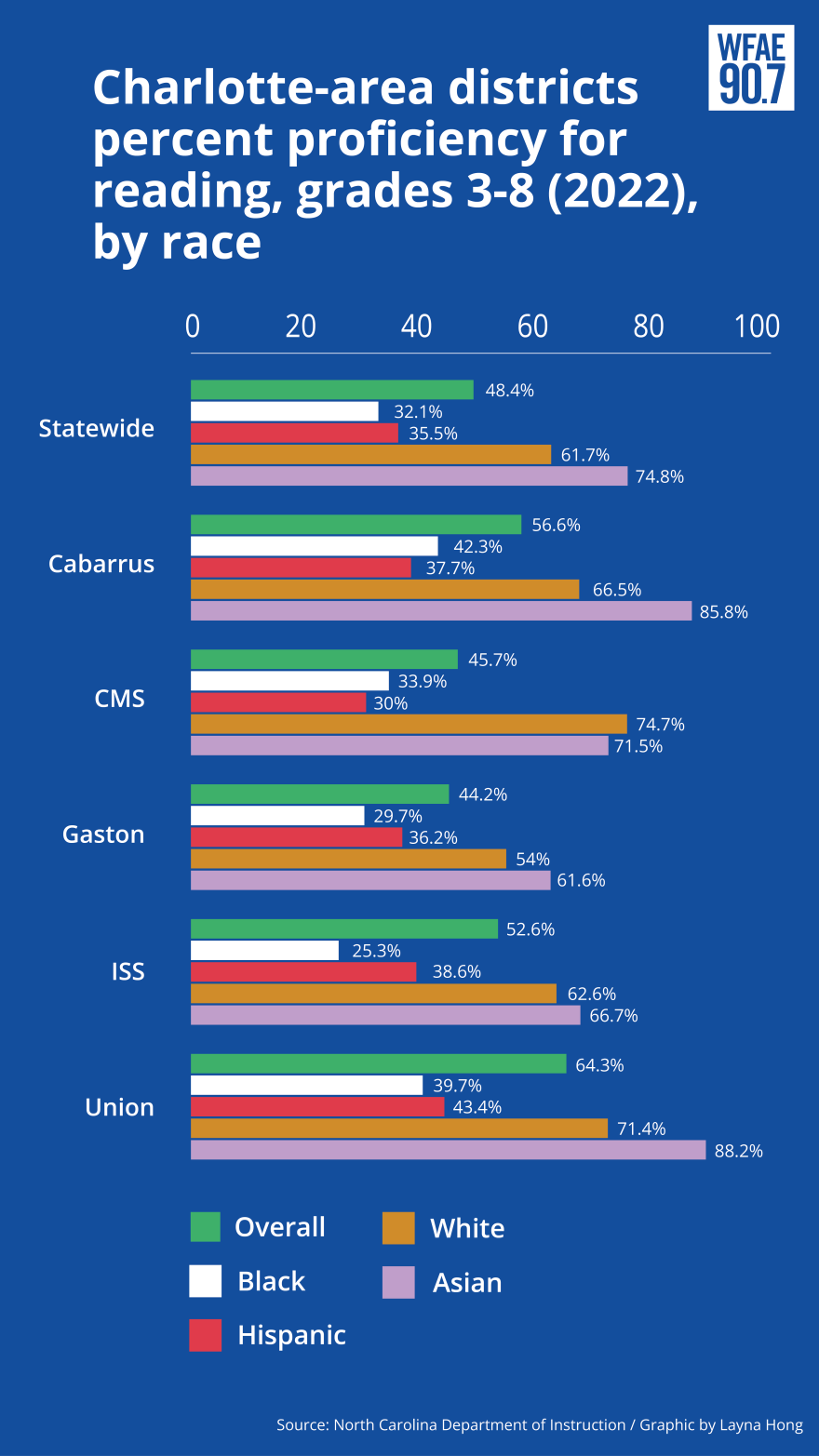The five largest districts in the Charlotte area all made gains in reading and math last year. None returned to pre-pandemic levels. And none has eliminated the racial and economic disparities that persist in districts across America.
Because of those disparities, district averages can be deceiving: Districts with more white and Asian students and fewer students from low-income homes almost always look better. But same-group comparisons of the results for elementary and middle school reading and math show significant differences in the region.


Union and Cabarrus county schools significantly outperform state averages on most measures, while Gaston County consistently falls short. Charlotte-Mecklenburg Schools is a mixed bag, with white students topping state averages while Hispanic students trail their counterparts across the state and region.
Here’s what the 2022 test scores show.
Charlotte-Mecklenburg Schools
Racial disparities are wide in North Carolina’s second-largest school district. White students, who made up not quite a quarter of last year’s student body, performed well above state averages, with almost 75% proficient in reading and 81% in math. Those were the highest levels among the five large districts in the region.
Black students, the largest racial group in CMS, performed slightly above the state average, with 34% proficient in reading and math. Hispanic students, the second-largest group, were slightly below state averages, with 30% proficient in reading and 37% in math.
The CMS board has set goals for improving Black and Hispanic scores in third grade reading by 2024. Those goals are pegged to scores labeled “college and career ready,” a higher bar than grade-level proficiency. The target is to have 45% of both groups hit that goal by 2024, and the 2022 results show the district has a long way to go. Just over 19% of Black students hit that mark, up from 18% in 2021. And Hispanic third-graders lost ground, going from almost 14% hitting the target in 2021 to less than 13% in 2022.
Asian students, who made up less than 10% of CMS students, logged strong results: 71.5% proficient in reading and 81% in math. That’s virtually the same as the state average for Asian students in math, and a bit below the state average in reading.
CMS students classified as economically disadvantaged scored slightly below state averages for that group, with just under 29% proficient in reading and 31% in math.
Union County Public Schools
Union County officials boasted of being at or near the top of North Carolina’s results for most groups in 2021, when the district brought back in-person classes faster than many other districts.
That advantage remained in 2022, with Union County students significantly topping state averages for white, Black, Hispanic, Asian and economically disadvantaged students in both subjects.
Union County had the region’s highest proficiency rates for Hispanic students in reading (43%) and math (55%), for Asian students in reading (88%) and math (95%), and for economically disadvantaged students in math (43%).
Union County is the state’s sixth-largest district and is majority white.
Cabarrus County Schools
Cabarrus, the state’s eighth-largest district, was also above state averages in all racial groups, generally by significant margins. It had the region’s highest proficiency levels for Black students in reading (42%) and math (43%).
Cabarrus was slightly above state averages for economically disadvantaged students in reading and math.
Those scores do not include students in Kannapolis, which has its own school district.
Gaston County Schools
Gaston County came in below state averages for Black students in reading (30%) and math (29%), for Hispanic students in math (37%), and for Asian students in reading (62%) and math (73%). It was the only district in the region to fall below state averages for white students, in both reading (54%) and math (57%).
Gaston’s was within a percentage point of the state average for economically disadvantaged students in both subjects and for Hispanic students in reading.
Gaston is North Carolina’s 10th-largest district.
Iredell-Statesville Schools
Iredell-Statesville Schools had a wide range of results. Its economically disadvantaged students performed well above state averages and logged the region’s best proficiency rate at 41% in reading and 43% in math. Hispanic students also topped the state average in both subjects.
Yet Black students in ISS logged only 25% proficiency in reading and math, the lowest in the region and well below the state average.
White and Asian students in ISS fell in the middle, with white students topping the state average in math (67%) and inching past it in reading (63%). Asian students were below the state average in reading (67%) and matched it in math (82%).
Those scores do not include students in the Mooresville Graded School District.




